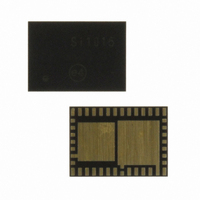SI1015-A-GM Silicon Laboratories Inc, SI1015-A-GM Datasheet - Page 25

SI1015-A-GM
Manufacturer Part Number
SI1015-A-GM
Description
IC TXRX MCU + EZRADIOPRO
Manufacturer
Silicon Laboratories Inc
Specifications of SI1015-A-GM
Package / Case
42-QFN
Frequency
240MHz ~ 960MHz
Data Rate - Maximum
256kbps
Modulation Or Protocol
FSK, GFSK, OOK
Applications
General Purpose
Power - Output
13dBm
Sensitivity
-121dBm
Voltage - Supply
0.9 V ~ 3.6 V
Current - Receiving
18.5mA
Current - Transmitting
30mA
Data Interface
PCB, Surface Mount
Memory Size
8kB Flash, 768B RAM
Antenna Connector
PCB, Surface Mount
Number Of Receivers
1
Number Of Transmitters
1
Wireless Frequency
240 MHz to 960 MHz
Interface Type
UART, SMBus, SPI, PCA
Output Power
13 dBm
Operating Supply Voltage
0.9 V to 3.6 V
Maximum Operating Temperature
+ 85 C
Mounting Style
SMD/SMT
Maximum Supply Current
4 mA
Minimum Operating Temperature
- 40 C
Modulation
FSK, GFSK, OOK
Protocol Supported
C2, SMBus
Core
8051
Program Memory Type
Flash
Program Memory Size
8 KB
Data Ram Size
768 B
Supply Current (max)
4 mA
Lead Free Status / RoHS Status
Lead free / RoHS Compliant
Operating Temperature
-
Lead Free Status / Rohs Status
Lead free / RoHS Compliant
Other names
336-1868-5
Available stocks
Company
Part Number
Manufacturer
Quantity
Price
Company:
Part Number:
SI1015-A-GM
Manufacturer:
Silicon Labs
Quantity:
135
Part Number:
SI1015-A-GM
Manufacturer:
SILICONLA
Quantity:
20 000
- Current page: 25 of 384
- Download datasheet (3Mb)
1.2. CIP-51™ Microcontroller Core
1.2.1. Fully 8051 Compatible
The Si1010/1/2/3/4/5 family utilizes Silicon Labs' proprietary CIP-51 microcontroller core. The CIP-51 is
fully compatible with the MCS-51™ instruction set; standard 803x/805x assemblers and compilers can be
used to develop software. The CIP-51 core offers all the peripherals included with a standard 8052.
1.2.2. Improved Throughput
The CIP-51 employs a pipelined architecture that greatly increases its instruction throughput over the stan-
dard 8051 architecture. In a standard 8051, all instructions except for MUL and DIV take 12 or 24 system
clock cycles to execute with a maximum system clock of 12-to-24 MHz. By contrast, the CIP-51 core exe-
cutes 70% of its instructions in one or two system clock cycles, with only four instructions taking more than
four system clock cycles.
The CIP-51 has a total of 109 instructions. The table below shows the total number of instructions that
require each execution time.
With the CIP-51's maximum system clock at 25 MHz, it has a peak throughput of 25 MIPS.
1.2.3. Additional Features
The Si1010/1/2/3/4/5 SoC family includes several key enhancements to the CIP-51 core and peripherals to
improve performance and ease of use in end applications.
The extended interrupt handler provides multiple interrupt sources into the CIP-51 allowing numerous ana-
log and digital peripherals to interrupt the controller. An interrupt driven system requires less intervention
by the MCU, giving it more effective throughput. The extra interrupt sources are very useful when building
multi-tasking, real-time systems.
Eight reset sources are available: power-on reset circuitry (POR), an on-chip V
when power supply voltage drops below safe levels), a Watchdog Timer, a Missing Clock Detector,
SmaRTClock oscillator fail or alarm, a voltage level detection from Comparator0, a forced software reset,
an external reset pin, and an illegal Flash access protection circuit. Each reset source except for the POR,
Reset Input Pin, or Flash error may be disabled by the user in software. The WDT may be permanently dis-
abled in software after a power-on reset during MCU initialization.
The internal oscillator factory calibrated to 24.5 MHz and is accurate to ±2% over the full temperature and
supply range. The internal oscillator period can also be adjusted by user firmware. An additional 20 MHz
low power oscillator is also available which facilitates low-power operation. An external oscillator drive cir-
cuit is included, allowing an external crystal, ceramic resonator, capacitor, RC, or CMOS clock source to
generate the system clock. If desired, the system clock source may be switched on-the-fly between both
internal and external oscillator circuits. An external oscillator can also be extremely useful in low power
applications, allowing the MCU to run from a slow (power saving) source, while periodically switching to
the fast (up to 25 MHz) internal oscillator as needed.
Clocks to Execute
Number of Instructions
1
26
2
50
2/3
5
Rev. 1.0
3
14
3/4
7
4
3
Si1010/1/2/3/4/5
4/5
1
DD
monitor (forces reset
5
2
8
1
25
Related parts for SI1015-A-GM
Image
Part Number
Description
Manufacturer
Datasheet
Request
R
Part Number:
Description:
SMD/C°/SINGLE-ENDED OUTPUT SILICON OSCILLATOR
Manufacturer:
Silicon Laboratories Inc
Part Number:
Description:
Manufacturer:
Silicon Laboratories Inc
Datasheet:
Part Number:
Description:
N/A N/A/SI4010 AES KEYFOB DEMO WITH LCD RX
Manufacturer:
Silicon Laboratories Inc
Datasheet:
Part Number:
Description:
N/A N/A/SI4010 SIMPLIFIED KEY FOB DEMO WITH LED RX
Manufacturer:
Silicon Laboratories Inc
Datasheet:
Part Number:
Description:
N/A/-40 TO 85 OC/EZLINK MODULE; F930/4432 HIGH BAND (REV E/B1)
Manufacturer:
Silicon Laboratories Inc
Part Number:
Description:
EZLink Module; F930/4432 Low Band (rev e/B1)
Manufacturer:
Silicon Laboratories Inc
Part Number:
Description:
I°/4460 10 DBM RADIO TEST CARD 434 MHZ
Manufacturer:
Silicon Laboratories Inc
Part Number:
Description:
I°/4461 14 DBM RADIO TEST CARD 868 MHZ
Manufacturer:
Silicon Laboratories Inc
Part Number:
Description:
I°/4463 20 DBM RFSWITCH RADIO TEST CARD 460 MHZ
Manufacturer:
Silicon Laboratories Inc
Part Number:
Description:
I°/4463 20 DBM RADIO TEST CARD 868 MHZ
Manufacturer:
Silicon Laboratories Inc
Part Number:
Description:
I°/4463 27 DBM RADIO TEST CARD 868 MHZ
Manufacturer:
Silicon Laboratories Inc
Part Number:
Description:
I°/4463 SKYWORKS 30 DBM RADIO TEST CARD 915 MHZ
Manufacturer:
Silicon Laboratories Inc
Part Number:
Description:
N/A N/A/-40 TO 85 OC/4463 RFMD 30 DBM RADIO TEST CARD 915 MHZ
Manufacturer:
Silicon Laboratories Inc
Part Number:
Description:
I°/4463 20 DBM RADIO TEST CARD 169 MHZ
Manufacturer:
Silicon Laboratories Inc











